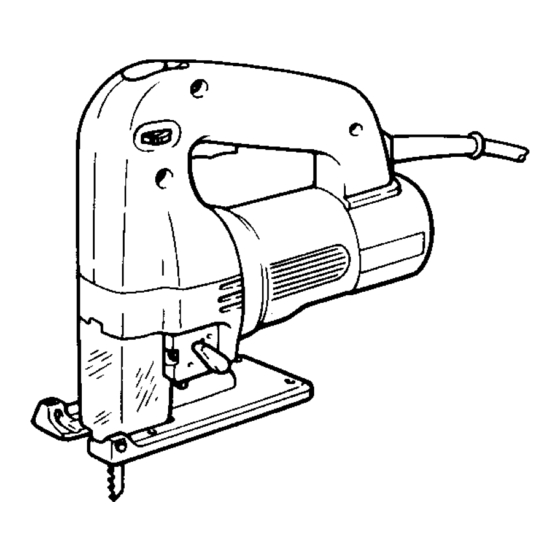Makita 4305 Gebruikershandleiding - Pagina 8
Blader online of download pdf Gebruikershandleiding voor {categorie_naam} Makita 4305. Makita 4305 8 pagina's. Variable speed
Ook voor Makita 4305: Gebruiksaanwijzing (20 pagina's)

Continuous running (Fig. 4)
For 4304 only
Press the trigger and at the same time move the lock
lever backward. To stop from this lock position, press the
trigger and release it.
Speed adjusting dial
(Fig. 4 for 4304 and Fig. 5 for 4305)
The tool speed can be adjusted between 500 and 3,000
strokes per minute by turning the adjusting dial. The dial
is marked 1 (lowest speed) to 6 (full speed). Refer to the
table below to select the proper speed for the workpiece
to be cut. However, the appropriate speed may differ
with the type or thickness of the workpiece. In general,
higher speeds will allow you to cut workpieces faster but
the service life of the blade will be reduced.
Workpiece to be cut
Wood
Mild steel
Stainless steel
Aluminum
Plastics
Cutting operation (Fig. 6)
Rest the base flat on the workpiece and gently move the
tool forward along the previously marked cutting line.
When cutting curves, advance the tool very slowly.
Bevel cutting (Fig. 7 & 8)
With the base tilted, you can make bevel cuts at any
angle between 0° and 45° (left or right). Loosen the bolt
on the bottom of the tool. Move the base so that the bolt
is positioned in the center of the cross-shaped slot in the
base. Tilt the base until the desired bevel angle is
obtained. The edge of the motor housing indicates the
bevel angle. (See Fig. 8) Then tighten the bolt to secure
the base.
Flush cutting (Fig. 9)
Loosen the bolt on the bottom of the tool and move the
base all the way back. Then tighten the bolt to secure the
blade.
Cutouts
Cutouts can be made with either of two methods A or B.
A) Boring a starting hole:
For internal cutouts without a lead-in cut from an
edge, pre-drill a starting hole more than 12 mm in
diameter. Insert the blade into this hole to start
your cut. (Fig. 10)
B) Plunge cutting:
Your need not bore a starting hole or make a
lead-in cut if you carefully do as follows:
Number on
adjusting dial
5 – 6
3 – 6
3 – 4
2 – 3
1 – 4
Makita Corporation
Anjo, Aichi, Japan
883895C220
1.
Tilt the tool up on the front edge of the base, with the
blade point positioned just above the workpiece sur-
face. (Fig. 11)
2.
Apply pressure to the tool so that the front edge of
the base will not move when you switch on the tool
and gently lower the back end of the tool slowly.
3.
As the blade pierces the workpiece, slowly lower the
base of the tool down onto the workpiece surface.
4.
Complete the cut in the normal manner.
Finishing edges (Fig. 12)
To trim edges or make dimensional adjustments, run the
blade lightly along the cut edges.
Metal cutting
Always use a suitable coolant (cutting oil) when cutting
metal. Failure to do so will cause significant blade wear.
The underside of the workpiece can be greased instead
of using a coolant.
Plastic base plate (Fig. 13)
Use the plastic base plate when cutting decorative
veneers, plastics, etc. It protects sensitive surfaces from
damage. To replace the base plate, remove the four
screws.
Anti-splintering devise (Fig. 14)
For splinter-free cuts, the anti-splintering device can be
used. Fit it into the base from below.
Guide rule (optional accessory) (Fig. 15)
When cutting widths of under 150 mm repeatedly, use of
the guide rule (rip fence) will assure fast, clean, straight
cuts. To install it, loosen the bolt on the front of the base.
Slip in the guide rule and secure the bolt.
Circular guide (optional accessory) (Fig. 16)
Use of the circular guide insures clean, smooth cutting of
circles (radius; under 200 mm. Insert the pin through the
center hole and secure it with the threaded knob. Move
the base of the tool forward fully. Then install the circular
guide on the base in the same manner as the guide rule
(rip fence).
Dust extraction (Fig. 17, 18 & 19)
The vacuum head is recommended to perform clean cut-
ting operations. Install the plastic cover on the tool by fit-
ting it into the notches in the tool.
To attach the vacuum head on the tool, insert the hook of
the vacuum head into the hole in the base. The vacuum
head can be installed on either left or right side of the
base. Then connect a Makita vacuum cleaner to the vac-
uum head.
MAINTENANCE
CAUTION:
Always be sure that the tool is switched off and
unplugged before carrying out any work on the tool.
To maintain product safety and reliability, repairs, mainte-
nance or adjustment should be carried out by a Makita
Authorized Service Center.
